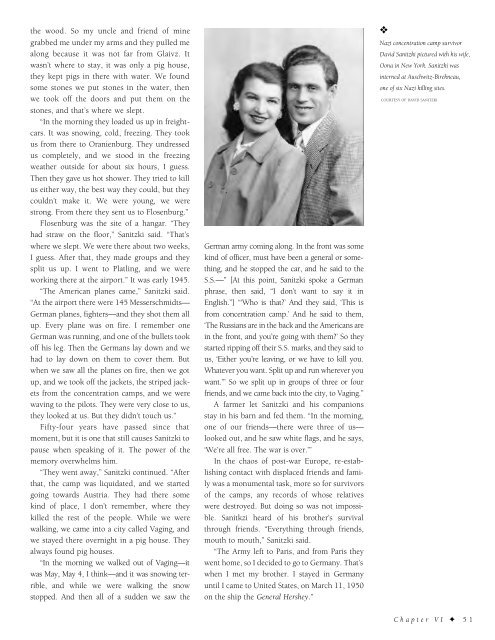Historic Laredo
An illustrated history of the city of Laredo and the Webb County area, paired with the histories of companies, families and organizations that make the region great.
An illustrated history of the city of Laredo and the Webb County area, paired with the histories of companies, families and organizations that make the region great.
Create successful ePaper yourself
Turn your PDF publications into a flip-book with our unique Google optimized e-Paper software.
the wood. So my uncle and friend of mine<br />
grabbed me under my arms and they pulled me<br />
along because it was not far from Glaivz. It<br />
wasn’t where to stay, it was only a pig house,<br />
they kept pigs in there with water. We found<br />
some stones we put stones in the water, then<br />
we took off the doors and put them on the<br />
stones, and that’s where we slept.<br />
“In the morning they loaded us up in freightcars.<br />
It was snowing, cold, freezing. They took<br />
us from there to Oranienburg. They undressed<br />
us completely, and we stood in the freezing<br />
weather outside for about six hours, I guess.<br />
Then they gave us hot shower. They tried to kill<br />
us either way, the best way they could, but they<br />
couldn’t make it. We were young, we were<br />
strong. From there they sent us to Flosenburg.”<br />
Flosenburg was the site of a hangar. “They<br />
had straw on the floor,” Sanitzki said. “That’s<br />
where we slept. We were there about two weeks,<br />
I guess. After that, they made groups and they<br />
split us up. I went to Platling, and we were<br />
working there at the airport.” It was early 1945.<br />
“The American planes came,” Sanitzki said.<br />
“At the airport there were 145 Messerschmidts—<br />
German planes, fighters—and they shot them all<br />
up. Every plane was on fire. I remember one<br />
German was running, and one of the bullets took<br />
off his leg. Then the Germans lay down and we<br />
had to lay down on them to cover them. But<br />
when we saw all the planes on fire, then we got<br />
up, and we took off the jackets, the striped jackets<br />
from the concentration camps, and we were<br />
waving to the pilots. They were very close to us,<br />
they looked at us. But they didn’t touch us.”<br />
Fifty-four years have passed since that<br />
moment, but it is one that still causes Sanitzki to<br />
pause when speaking of it. The power of the<br />
memory overwhelms him.<br />
“They went away,” Sanitzki continued. “After<br />
that, the camp was liquidated, and we started<br />
going towards Austria. They had there some<br />
kind of place, I don’t remember, where they<br />
killed the rest of the people. While we were<br />
walking, we came into a city called Vaging, and<br />
we stayed there overnight in a pig house. They<br />
always found pig houses.<br />
“In the morning we walked out of Vaging—it<br />
was May, May 4, I think—and it was snowing terrible,<br />
and while we were walking the snow<br />
stopped. And then all of a sudden we saw the<br />
German army coming along. In the front was some<br />
kind of officer, must have been a general or something,<br />
and he stopped the car, and he said to the<br />
S.S.—” [At this point, Sanitzki spoke a German<br />
phrase, then said, “I don’t want to say it in<br />
English.”] “‘Who is that?’ And they said, ‘This is<br />
from concentration camp.’ And he said to them,<br />
‘The Russians are in the back and the Americans are<br />
in the front, and you’re going with them?’ So they<br />
started ripping off their S.S. marks, and they said to<br />
us, ‘Either you’re leaving, or we have to kill you.<br />
Whatever you want. Split up and run wherever you<br />
want.’” So we split up in groups of three or four<br />
friends, and we came back into the city, to Vaging.”<br />
A farmer let Sanitzki and his companions<br />
stay in his barn and fed them. “In the morning,<br />
one of our friends—there were three of us—<br />
looked out, and he saw white flags, and he says,<br />
‘We’re all free. The war is over.’”<br />
In the chaos of post-war Europe, re-establishing<br />
contact with displaced friends and family<br />
was a monumental task, more so for survivors<br />
of the camps, any records of whose relatives<br />
were destroyed. But doing so was not impossible.<br />
Sanitkzi heard of his brother’s survival<br />
through friends. “Everything through friends,<br />
mouth to mouth,” Sanitzki said.<br />
“The Army left to Paris, and from Paris they<br />
went home, so I decided to go to Germany. That’s<br />
when I met my brother. I stayed in Germany<br />
until I came to United States, on March 11, 1950<br />
on the ship the General Hershey.”<br />
❖<br />
Nazi concentration camp survivor<br />
David Sanitzki pictured with his wife,<br />
Oona in New York. Sanitzki was<br />
interned at Auschwitz-Birekneau,<br />
one of six Nazi killing sites.<br />
COURTESY OF DAVID SANITZKI<br />
Chapter VI ✦ 51
















